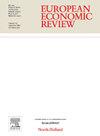基于内生网络的动态意见更新
IF 2.4
2区 经济学
Q1 ECONOMICS
引用次数: 0
摘要
在广泛的社会问题中,两极分化是一种有据可查的现象。然而,现有的理论往往将个人意见的演变和社会网络的形成视为两个独立的过程。在本研究中,我们研究了个体如何在形成和消解社会联系的同时动态调整自己的观点,突出了这些行为的相互关联性质。我们的模型基于两个关键参数:个人从社会关系中获得的直接利益,以及他们调整自己观点以与社交圈保持一致的意愿。我们确定了网络无法实现完全连接的条件,导致意见持续两极分化。此外,我们的模型表明,在向共识过渡的过程中,极化可能会暂时增加,这取决于意见的初始分布和网络结构。我们探讨了这些场景和一个关键网络指标之间的联系:初始直径,在特定条件下与意见的初始分布有关。本文章由计算机程序翻译,如有差异,请以英文原文为准。
Dynamic opinion updating with endogenous networks
Polarization is a well-documented phenomenon across a wide range of social issues. However, existing theories often treat the evolution of individual opinions and the formation of social networks as separate processes. In this study, we examine how individuals dynamically adjust their opinions while simultaneously forming and dissolving social connections, highlighting the interconnected nature of these behaviors. Our model is based on two key parameters: the direct benefit individuals receive from social connections and their willingness to adapt their opinions to align with their social circle. We identify conditions under which the network fails to achieve full connectivity, leading to persistent polarization of opinions. Additionally, our model demonstrates that polarization can temporarily increase during the transition to consensus, depending on the initial distribution of opinions and network structure. We explore the connection between these scenarios and a critical network metric: the initial diameter, under specific conditions related to the initial distribution of opinions.
求助全文
通过发布文献求助,成功后即可免费获取论文全文。
去求助
来源期刊

European Economic Review
ECONOMICS-
CiteScore
4.70
自引率
3.60%
发文量
170
期刊介绍:
The European Economic Review (EER) started publishing in 1969 as the first research journal specifically aiming to contribute to the development and application of economics as a science in Europe. As a broad-based professional and international journal, the EER welcomes submissions of applied and theoretical research papers in all fields of economics. The aim of the EER is to contribute to the development of the science of economics and its applications, as well as to improve communication between academic researchers, teachers and policy makers across the European continent and beyond.
 求助内容:
求助内容: 应助结果提醒方式:
应助结果提醒方式:


